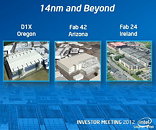Monday, January 21st 2013

Mass Production at Intel's 14 nanometer Node Begins This Year
In addition to the industry's first fully-patterned 450 mm wafer, Intel announced that its 14 nanometer silicon fabrication node at three of its fabs will begin this year. The next leap forward from 22 nm, on which two of the company's CPU generations "Ivy Bridge" and "Haswell" are based, the 14 nm node will eventually facilitate production of the company's 5th generation Core "Broadwell" processors, which are due to arrive in 2014. Given the pace at which the 14 nm node is being developed, some of the first Broadwell Core chips, at least engineering samples, will be released to the industry within 2013. Among the three Intel facilities with 14 nm nodes are D1X, located in Oregon; Fab 42, located in Arizona; and Fab 24, located in Ireland.
Source:
Expreview

11 Comments on Mass Production at Intel's 14 nanometer Node Begins This Year
Anyway, I'm hoping this "tick" will keep its feet numbered at 1150.
As far as node development, GloFo is already working on actual 20nm and 14nm concurrently. For those who don't know a node drop produces mostly a lower power consumption CPU/APU. With these micro node changes compared to the drop from 90nm to 65nm, there is minimal performance gains. In fact with the closer proximity of the transistors, there are thermal issues to deal with, as Intel found out with IB. FinFET/stacked transistors makers are going to need to address these thermal issues sooner than later.
oh wait, this is intel. :banghead: :roll:
Nobody's process node size is truly "actual size" anymore.
References:
Xbitlabs:BSN: